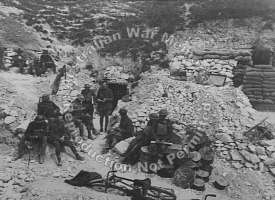
29 March 1918. View of the Somme Valley. Germans shelling the Somme Valley near Hamel in preparation for a further thrust of 30 March 1918 against the British line there. (The view is eastward from the heights north of the Somme). AWM E04663©
|
From the end of April 1918 with the
end of the German spring offensive in the Somme, Le Hamel and its surroundings
formed a small west salient in the German line facing the 4th British Army
(Rawlinson). A crest surmounted the village on the east and provided an
excellent observation of positions held by the Australian
Corps north of the river and west almost to Corbie along the river-banks
(see map).
The village of Le Hamel, was fortified and well defended, and was a key
defensive post for the Germans.
The capture of this sector would allow the Australians to get this key German observation post (see section). The defence of Villers-Bretonneux (6 km south) and of the main road to Amiens would be also improved. Moreover, the Allies needed a good base for future operations. So, holding Le Hamel was a very necessary preliminary for any major attack in this sector needing large-scale artillery support. If not, all preparations would be obvious to the Germans and the assault troops would be in sight of the enemy and exposed to flanking fire even before the attack. |




